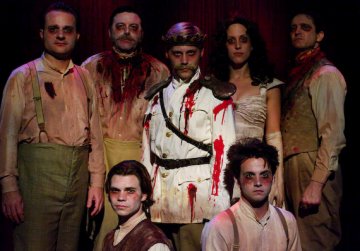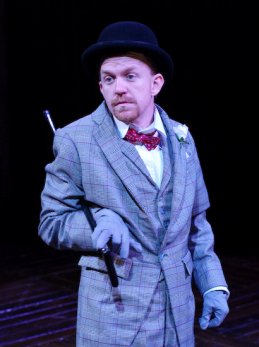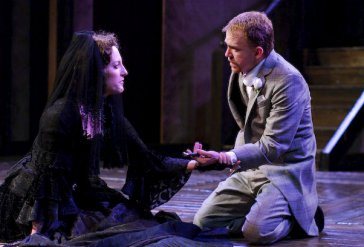Summary 
Strong outdoor production modernized to the 1930s and echoing the rise of fascism before World War II. A diminutive Richard, like a vaudeville entertainer, is haunted by the reappearing ghosts of his victims in an imaginative and effectively realized entertainment.
Design
Directed by Henry Woronicz. Costumes by Dorothy Marshall Engels. Set by John C. Stark. Lights by Julie Mack. Sound by Aaron Paolucci. Fights by C. Drew Vidal.
Cast
Kevin Rich (Richard), Ron Thomas (Clarence/Lord Mayor), Alexander S. Galick (Brakenbury), David Kortemeier (Hastings), Kate Cook (Lady Anne), Michelle Shupe (Queen Elizabeth), Raymond L. Chapman (Buckingham), Josephine Hall (Queen Margaret), Cody Proctor (Catesby), Brian Rooney (Edward IV), Wayne T. Carr (Ratcliffe), Chris Amos (Bishop of Ely/Tyrell).
Analysis
Henry Woronicz's outdoor production of Richard III uses the same basic staging as the Illinois Shakespeare Festival's other repertory productions - panels of dark planks across the stage, a series of wooden ramps, vertical sky-blue screens above the balcony - as well as the same small company of twenty young performers and a single scenic designer. Richard III adds mottled tan walls upstage and twenty-foot rust-red curtains above in the balcony, and Woronicz often utilizes a platform that slides out from beneath the balcony. Modernized to a time approximating the 1930s, the production is scored with a jaunty ragtime piano theme and costumed in a militaristic fashion that subtly denotes the rise of the Nazis in Berlin. Richard's political guile and lack of conscience can certainly equate to the power struggle won and lost by the Fascists before and during the second World War.

Woronicz's Richard III revolves around a waifish Richard, who balanced vaudeville theatrics with deliciously amoral ambition. Woronicz - a guest director and former artistic director of the Oregon Shakespeare Festival - focuses on consequences, presented in grisly images of zombie-like ghosts in a series of scenes leading to the "despair and die" cursing of Richard as despot. After Richard's deception of Edward's court in 2.1, he dismissively waves them offstage so he can crow to the audience in soliloquy, but he is startled by the upstage presence of the ghost of his brother Clarence, ashen, corpse-like, and staring in accusation. Later in 3.7, when Richard manipulates the Lord Mayor and a crowd of townspeople into believing him pious and prayerful, they disperse to reveal the bloody ghost of Hastings in their midst. The purple-robed queen Anne, beautiful and doomed, is led offstage 4.1 to her demise by the ghosts of both Clarence and Hastings, who disappear with her in the upstage darkness. And when Tyrell, alone in a downstage right spotlight for 4.3, recounts the brutal smothering of the princes, the ghosts of the two boys emerge within eerie light high above in the balcony.

Woronicz directs Kevin Rich as something of a vaudevillian entertainer, attired in a bowtie, gloves, and tails, with a flower in his lapel, sporting a bowler and a cane as well as a reddish goatee. The entire production is lavishly costumed - from the men in tailed tuxedoes, business suits with vests and ties, and dress military uniforms, to the women in flowing gowns with veils, gloves, and billowing sleeves - and Richard himself seems more out of place at the beginning in his simple checked suit, but after being crowned he luxuriates in an oversized royal crimson robe and an enormous crown. Stooped and withered, Rich's youthful Richard looks dwarfish and shrill in comparison to the soldiers nearby, especially the authoritative and booming Hastings. As ironically upbeat ragtime music plays the production begins, and Richard's "now 'tis the winter of our discontent" comment is a wry attempt at ironic humor to everyone onstage as Edward makes his appearance in the balcony, punctuated by shouts of "Long live King Edward!" and the throwing of confetti.
Rich's excellent timing borders on the comedic: "deformed?" he asks himself, a confident "unfinished" his reply; "I killed her husband...and her father," he notes of his soon-to-be-bride Anne; he demands "chop off his head!" but downplays the remark with a chuckle; he and Buckingham shout a rousingly sardonic "farewell!" to the deluded citizenry; and once crowned he cries out "King Richard!" and as he sits in his throne, "seated!" Rich's Richard is a preeminent showman, twirling his cane and tapping it for emphasis, smirking and mugging to the audience in response to the vitriol leveled at him. He gives a sardonic "amen" as he kneels for his mother's blessing, although he is beaten by her and falls flat upon his humped back, sniveling and wiping tears from his eyes with his palms. Bells chime as Richard reveals in soliloquy how he "can smile and murder." The curtains above the balcony glow in bloody Lancastrian red as Richard shouts at the top of his lungs downstage center, bringing the curtains down with a dramatic crash that blacks out to signal intermission. During the second half, Rich's Richard gradually loses the flair for vaudeville soliloquy he displayed in pursuit the crown, instead reduced to a haunted and uncertain king, prone to bouts of anger and fits of desperation, pacing in a limp as he twirls a ring on his withered hand. His expressions become headshakes and raised eyebrows of disbelief rather than the more typical knowing glances and smirks of amusement during his plotting. When he screams "I am not in the vein!" at Buckingham, he reveals himself as unbalanced, and he becomes frenzied in movement and speech, cocking his head and raising eyebrows, as though losing his grip on sanity. When faced with the impending invasion led by Richmond, Rich's Richard shouts, "is the chair empty?" then kicks over one of the "owls" who come to him with bad news before wiping at his brow and scratching at his cheek.
Strong supporting performances bolster this Richard III. Hastings, in mutton chops and gray mustache, wears a black-and-tan military uniform, stood tall and soldierly. When Hastings chucks Richard playfully under the chin as if he is a child, Richard's bemused expression smacks with his relish of imminent revenge. Margaret the curser walks in circles, black eyed and wan, wearing black as if culled directly from Macbeth. She stands by the bier of Henry VI, resting a red rose on his pillow, showing Lady Anne how the corpse bleeds anew, and observing the seduction by Richard from the edge of the stage. And with the stage lit in blue neon and with an ominous hum in the background, Margaret makes her curses, and later watches their realization from within shadowy doorways on either side of the sliding platform.

Kate Cook's Lady Anne is statuesque in mourning black, veiled and wearing lace gloves. Pallbearers in tailed black tuxedoes and gray gloves and dark armbands stand back as she attempts to defy the wooing Richard, but Cook's Anne is unsure of herself, devastated by grief over the loss of her husband and her father, her eyes searching and her voice quavering. She manages to spit in Richard's face, but his rising fury defeats her, and she kneels with him, still resisting but deeply frightened and emotionally exhausted. Not so much seduced as overwhelmed and intimidated, Cook's Anne slowly exits, mumbling to herself in disbelief. Richard checks that the pallbearers have exited before crowing to the audience: "I won't keep her long!" He shouts in triumph, gives a fist-pumping, "yeah!" and smirks at the notion that he is a "marvelous proper man." Later, when told she will be queen, Cook's tragic Anne intuits her fate and swoons, a hand to her breast, and later she returns, finally with some vestiges of confidence, but as a white-faced ghost of herself.
Subtle musical scoring features a haunting sequence of musical fragments, melodies, and sound effects that underscore and enhance the production. Plaintive piano notes drift softly as Buckingham's loyalty is revealed to the disheartened Margaret, and the thumping rhythm of drums that plays as Edward's council convenes becomes loud martial pounding as Richard's militaristic regime seizes authority. Richard's jaunty ragtime piano theme gives way to a more serious and ominous hum once he is crowned.
Woronicz stages a series of effective scenes with imaginative insight. Richard greets the murderers of his brother with a playful 1.3 game of keep-away with the written orders to remove Clarence's guard. The murderers, in ski caps and fingerless gloves, wake Clarence from his fetal-position nightmare 1.4 on one of the downstage ramps, stab him then pour water over his face from a bucket as he wheezes and gasps for breath. The ailing King Edward, wearing a light purple robe with a dark collar for 2.1, emerges on the platform in a wheelchair to urge unity, but collapses in a fit coughs and gasps at the news of Clarence's execution. Richard ascends 3.5 to the balcony to the sound of an offstage beheading, and Ratcliffe triumphantly drops a sack with Hastings's head down to Buckingham onstage. One of the Princes plays a pretend knife fight on the stairs, then mocks the withered arm and limp of his Protector uncle. The whole cast appears on the downstage right ramp for 3.7, dressed as commoners, wearing hats and murmuring. When they depart, Richard cries, "Call them again! Come back!" from above, shielding his eyes from the light, an acolyte on either side of him. He and Buckingham then manipulate the mob into a chant of "long live King Richard."
Woronicz pulls all the elements together - Rich's diminutive Richard, the haunting ghosts, the Fascist nature of the York regime - for a strong conclusion. White tents, built at either side of the stage, shield cots brought out for Richard and Richmond to sleep upon. The ghosts appear singly, Henry VI and Clarence first - "despair and die" - then walk to take a position on the center stage platform. Hastings, the princes, then Anne follow, with Buckingham last, and they all stand upon on the platform, posed like a grotesque family portrait, until Rich's Richard spasms out of his restless sleep. With drums resounding like horses' hoof beats, Woronicz's battle sequence begins with four sword contests at once, Richard beating away three attackers and screaming, "Richmond!" After his memorable desperation - "A horse, a horse, my kingdom for a horse" - Richard takes a swipe at the last of his allies, Catesby, before being confronted by Richmond. Rich's Richard manages a one-handed dagger attack at Richmond before the ghosts of Clarence and Hastings appear on the ramps and startle him. Then Henry VI and Buckingham appear in the doorways, and Richard panics, threatened from all sides not unlike the Nazis at Berlin in 1945. The ghosts close in on Richard as Anne appears in the balcony with the ghosts of the Princes, and Richmond muscles Richard offstage. As Richard screams in his death throes, the ghosts slowly disappear in the shadows upstage. Percy emerges amid rising lights to hand the crown to Richmond, and Woronicz's compelling and imaginative Richard III comes to its conclusion.
Note: A version of this article was edited and published in Shakespeare Bulletin, Vol. 28, No. 2, Summer 2010